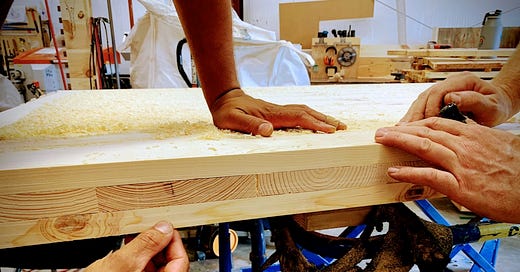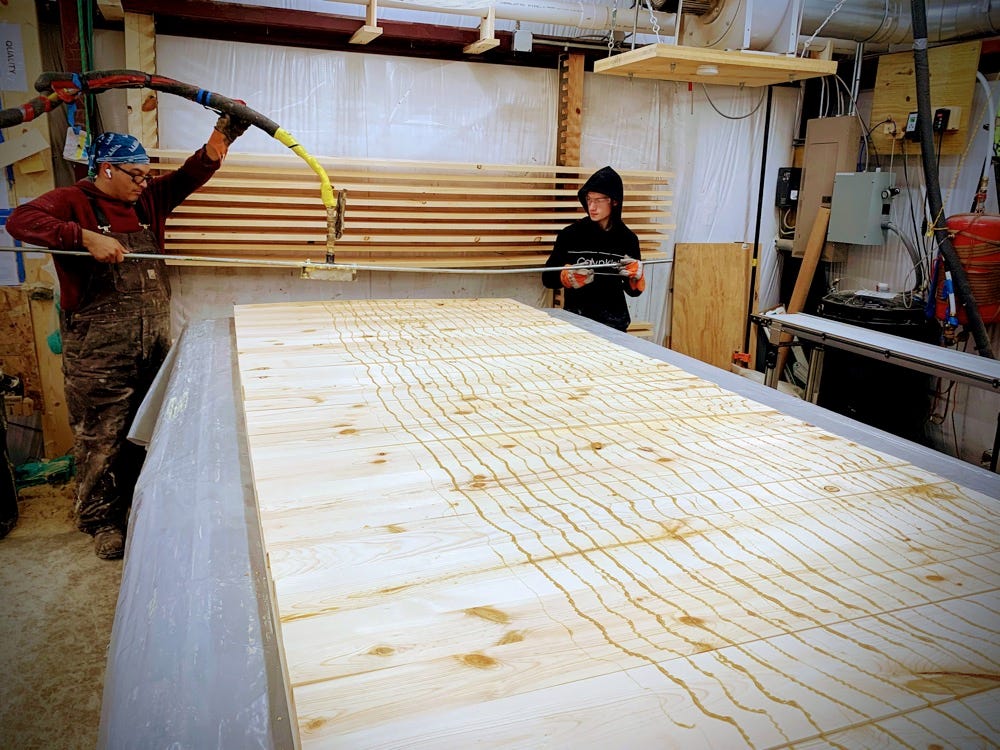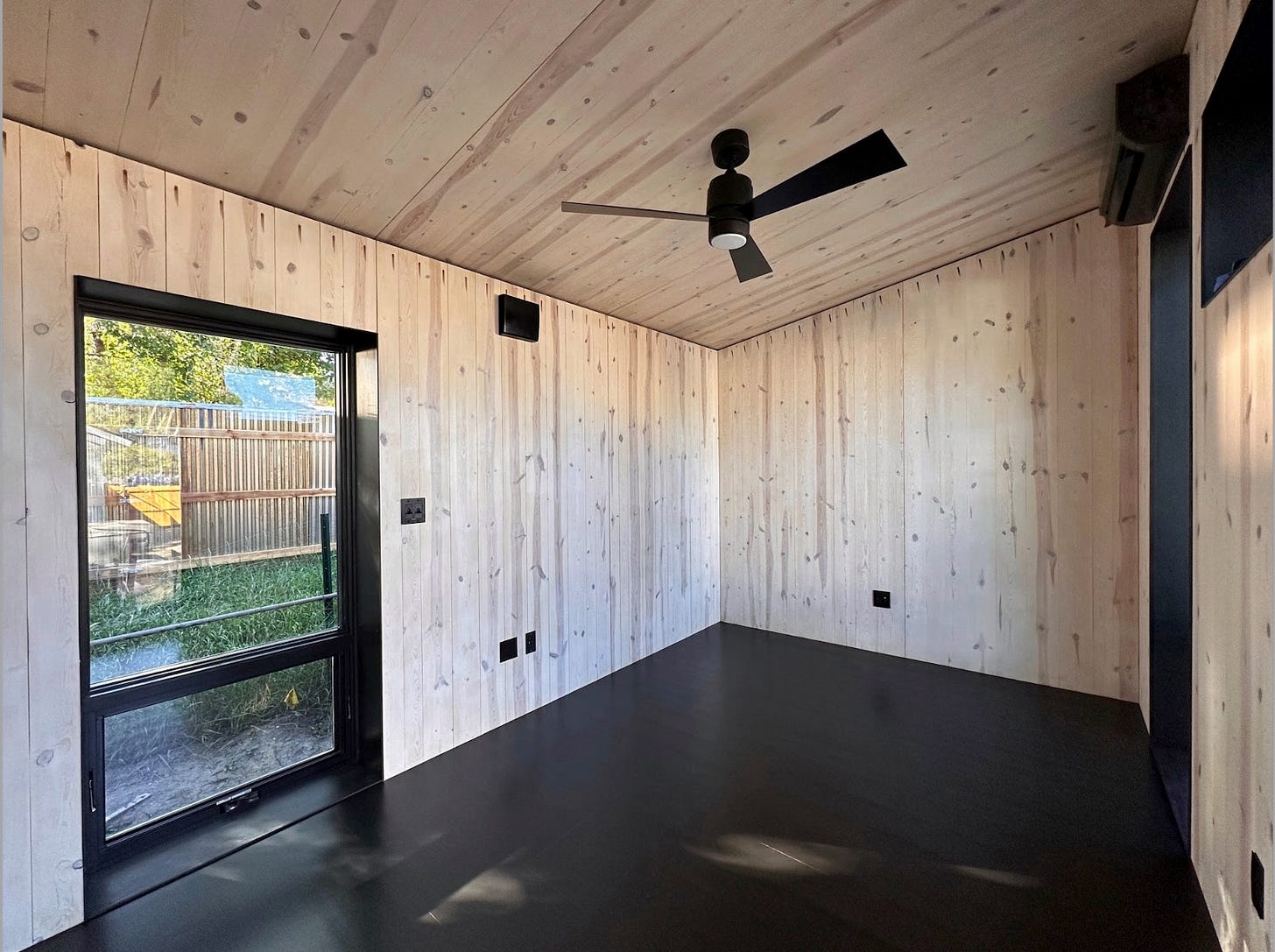Small CLT is Beautiful: A different model for mass timber
Timber Age goes to the forest and harvests trees that might otherwise burn.
The session at the Passive House Network conference in Denver was titled “Passive House, Embodied Carbon & Environmental Sustainability,” all my favourite buzzwords, and included personal hero Chris Magwood of RMI, so of course I had to go. I didn’t pay much attention to the other panellists, Kyle Hanson and Christopher Hamm of Timber Age Systems; a quick look at their website indicated that it made modular homes out of cross-laminated timber, which I have thought was one of the dumbest ideas in the construction industry.
I had my questions for them prepared in advance:
Why would you use CLT for low-rise construction when it uses 4.8 times as much wood fibre as a frame wall?
Why would you build modular out of CLT and use even more wood with the doubling up of walls and floors, be limited in your designs, and ship air instead of panels?
But it turns out that I had much to learn on both counts. While the modular industry (and I) consider modules to be boxes, Timber Age provides “panelized modular buildings,” which can be flat-packed. They call themselves “a modular home builder” but are providing a panel system, not a complete building.
And what an interesting panel system it is. It turns out that using 4.8 times as much wood is a feature, not a bug. All over the western United States, there are “hot spots” where forests of second-growth Ponderosa Pine need thinning to prevent them from going up in flames. In this case, the more wood used, the merrier.
Conventional CLT plants make giant panels with lamstock (laminating stock) made from graded dimension lumber (usually 2x6) squeezed in huge, expensive presses. Katerra spent $150 million building its ill-fated CLT plant in Spokane. Timber Age will set up 5,000-square-foot flying factories at about $2 million a pop to make “small” CLT.
Timber Age goes to where the pine is with its own sawmill, and cuts up thinner lamstock at 5/4 inches thick. (that’s why the Ponderosa Pines are still standing- they are too small to make regular dimension lumber efficiently)
Timber Age lays it up in smaller panels, so it doesn’t need the expensive finger-jointing machine required to make longer lamstock. They spread the glue by hand and then use a homemade vacuum press, where you suck out the air and let the atmosphere, at 8.5 tonnes per square meter, do the work.
So, the panel isn’t as big or strong or thick as a conventional CLT panel and doesn’t yet meet standards like PRG 320. Who cares? They are not building timber towers, and the panels are more than strong enough for one and two-storey buildings.
They take their home-baked CLT and add a breathable air barrier (Wrapshield IT- I have this on my own home; see Help, my house is covered in sticky orange frogs). I-joists are added to provide a space for insulation (and stiffen the wall even further) Add some battens to hold the future exterior siding, fill with cellulose insulation. and more Wrapshield to hold it all together. Truck them to the site, tilt them up, drop the roof on, and voila: a building that should hit the Passive House standard.
Even Chris Magwood, a notable skeptic about CLT, is impressed with the way they are using wood that would otherwise likely burn, and turning mass timber into a local business with limited transport distances. It’s an instant wall that doesn’t need drywall or other finishes and looks and smells great.
There were some lessons learned here. My mantra, learned from engineer Will Arnold, is always “use less stuff,” but these guys show that it isn’t always true, and my preconceived notions are not always right. And as E. F. Schumacher noted, small is beautiful.










30 Years ago I was mucking about in a barn generally puzzled by a straw bale assembly being tested when I got a visit from Robert Platz Scanada consulting and he had brought a senior gentleman up from CMHC. CMHC had provided us the funding and everyone was happy, except me. This was all turning out to be much harder than I anticipated. The visitor engaged me with compliments and small talk and it was much like many other PR encounters until the conversation switched to
CLT‘s, an industry which he had helped create. It turns out that making CLT is very very wasteful and he thought that the work we were doing with waste fibres was a potentially good solution to their problems.
I thought about it for about three seconds and flatly refused. Bob was stunned. By all accounts that was about the most stupid professional decision I have ever made.
Except it wasn’t. Carbon is more than just wood and a resource that we can do whatever we want with. For the record It’s not about CLT or even straw bales...it’s about forestry on steroids where ancient 1000 years old forests got destroyed IN ONE HUMAN LIFETIME ! We are not the only special ones to consider and as far as anyone knows, our planet is our only known home and it is a mosaic of life beyond our comprehension. Yea we can, but if wisdom is a good guide then maybe...
mass timber AND I joists? Either, including studs, could hold up the house.
- is the CLT being used for its interior finish effects (beware fashion trends)
- is the wood in the CLT of too poor quality to use as double stud wall , truss wall. 2x4 advanced framing all of which is ample strong enough for modular or panelized construction.
- could the CLT be made from wood more flawed than is usable as studs
- speak more about the economics of selective logging. the Ministry of Forests seems intent on industrial logging to: allow current loggers to pay off their feller-butchers, feed mega mills, the highway standard logging access roads, burning of fibre left behind etc.
- beware the arguments for expansion of logging. How will non industrial logging be
- the CLT and other finishes, insulation etc. would need to be reconstructible and modularized for reuse
I do support the exploration of lower grade, lighter CLT for, as you have often proposed, for select structural applications.
Peter T
Loyd, have you become too enthusiastic?